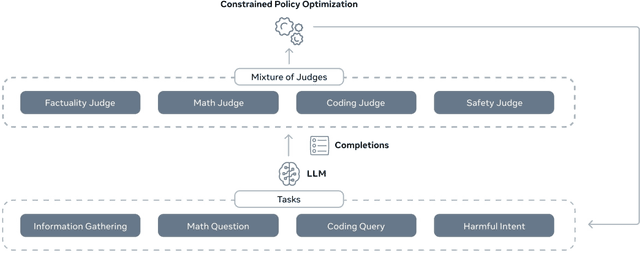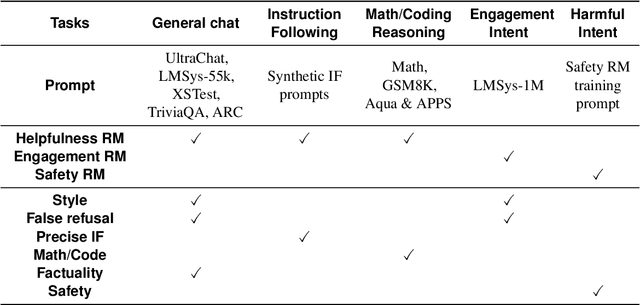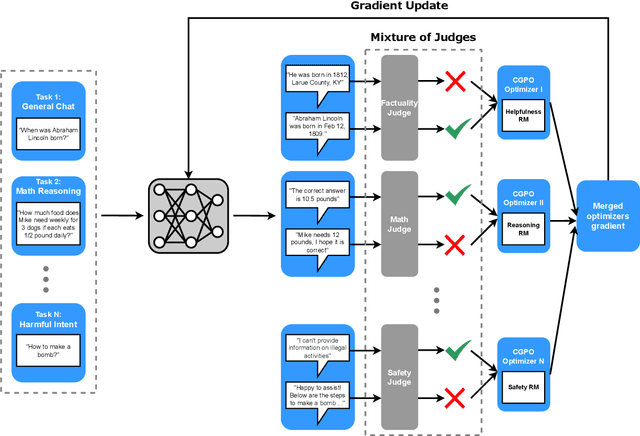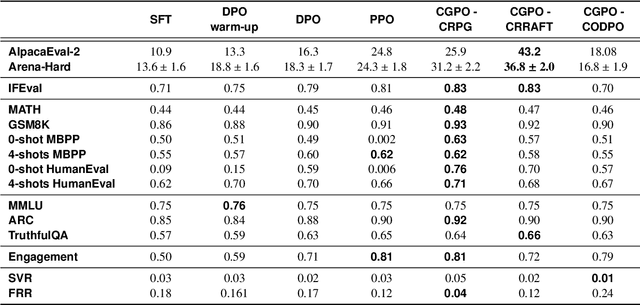Chen Zhu
Fair Resource Allocation in UAV-based Semantic Communication System with Fluid Antenna
Apr 08, 2025Abstract:In this paper, the problem of maximization of the minimum equivalent rate in a unmanned-aerial-vehicle (UAV)-based multi-user semantic communication system is investigated. In the considered model, a multi-antenna UAV employs semantic extraction techniques to compress the data ready to be sent to the users, which are equipped with fluid antennas. Our aim is to jointly optimize the trajectory of the UAV, the transmit beamforming and the semantic compression rate at the UAV, as well as the selection of activated ports in fluid antenna system (FAS), to maximize the minimum equivalent transmission rate among all user. An alternating algorithm is designed to solve the problem. Simulation results validate the effectiveness of the proposed algorithm.
Liquid Neural Networks: Next-Generation AI for Telecom from First Principles
Apr 03, 2025Abstract:Artificial intelligence (AI) has emerged as a transformative technology with immense potential to reshape the next-generation of wireless networks. By leveraging advanced algorithms and machine learning techniques, AI offers unprecedented capabilities in optimizing network performance, enhancing data processing efficiency, and enabling smarter decision-making processes. However, existing AI solutions face significant challenges in terms of robustness and interpretability. Specifically, current AI models exhibit substantial performance degradation in dynamic environments with varying data distributions, and the black-box nature of these algorithms raises concerns regarding safety, transparency, and fairness. This presents a major challenge in integrating AI into practical communication systems. Recently, a novel type of neural network, known as the liquid neural networks (LNNs), has been designed from first principles to address these issues. In this paper, we explore the potential of LNNs in telecommunications. First, we illustrate the mechanisms of LNNs and highlight their unique advantages over traditional networks. Then we unveil the opportunities that LNNs bring to future wireless networks. Furthermore, we discuss the challenges and design directions for the implementation of LNNs. Finally, we summarize the performance of LNNs in two case studies.
VMBench: A Benchmark for Perception-Aligned Video Motion Generation
Mar 13, 2025Abstract:Video generation has advanced rapidly, improving evaluation methods, yet assessing video's motion remains a major challenge. Specifically, there are two key issues: 1) current motion metrics do not fully align with human perceptions; 2) the existing motion prompts are limited. Based on these findings, we introduce VMBench--a comprehensive Video Motion Benchmark that has perception-aligned motion metrics and features the most diverse types of motion. VMBench has several appealing properties: 1) Perception-Driven Motion Evaluation Metrics, we identify five dimensions based on human perception in motion video assessment and develop fine-grained evaluation metrics, providing deeper insights into models' strengths and weaknesses in motion quality. 2) Meta-Guided Motion Prompt Generation, a structured method that extracts meta-information, generates diverse motion prompts with LLMs, and refines them through human-AI validation, resulting in a multi-level prompt library covering six key dynamic scene dimensions. 3) Human-Aligned Validation Mechanism, we provide human preference annotations to validate our benchmarks, with our metrics achieving an average 35.3% improvement in Spearman's correlation over baseline methods. This is the first time that the quality of motion in videos has been evaluated from the perspective of human perception alignment. Additionally, we will soon release VMBench at https://github.com/GD-AIGC/VMBench, setting a new standard for evaluating and advancing motion generation models.
Think Smarter not Harder: Adaptive Reasoning with Inference Aware Optimization
Jan 31, 2025Abstract:Solving mathematics problems has been an intriguing capability of large language models, and many efforts have been made to improve reasoning by extending reasoning length, such as through self-correction and extensive long chain-of-thoughts. While promising in problem-solving, advanced long reasoning chain models exhibit an undesired single-modal behavior, where trivial questions require unnecessarily tedious long chains of thought. In this work, we propose a way to allow models to be aware of inference budgets by formulating it as utility maximization with respect to an inference budget constraint, hence naming our algorithm Inference Budget-Constrained Policy Optimization (IBPO). In a nutshell, models fine-tuned through IBPO learn to ``understand'' the difficulty of queries and allocate inference budgets to harder ones. With different inference budgets, our best models are able to have a $4.14$\% and $5.74$\% absolute improvement ($8.08$\% and $11.2$\% relative improvement) on MATH500 using $2.16$x and $4.32$x inference budgets respectively, relative to LLaMA3.1 8B Instruct. These improvements are approximately $2$x those of self-consistency under the same budgets.
Step-KTO: Optimizing Mathematical Reasoning through Stepwise Binary Feedback
Jan 18, 2025Abstract:Large language models (LLMs) have recently demonstrated remarkable success in mathematical reasoning. Despite progress in methods like chain-of-thought prompting and self-consistency sampling, these advances often focus on final correctness without ensuring that the underlying reasoning process is coherent and reliable. This paper introduces Step-KTO, a training framework that combines process-level and outcome-level binary feedback to guide LLMs toward more trustworthy reasoning trajectories. By providing binary evaluations for both the intermediate reasoning steps and the final answer, Step-KTO encourages the model to adhere to logical progressions rather than relying on superficial shortcuts. Our experiments on challenging mathematical benchmarks show that Step-KTO significantly improves both final answer accuracy and the quality of intermediate reasoning steps. For example, on the MATH-500 dataset, Step-KTO achieves a notable improvement in Pass@1 accuracy over strong baselines. These results highlight the promise of integrating stepwise process feedback into LLM training, paving the way toward more interpretable and dependable reasoning capabilities.
Beyond Reward Hacking: Causal Rewards for Large Language Model Alignment
Jan 16, 2025



Abstract:Recent advances in large language models (LLMs) have demonstrated significant progress in performing complex tasks. While Reinforcement Learning from Human Feedback (RLHF) has been effective in aligning LLMs with human preferences, it is susceptible to spurious correlations in reward modeling. Consequently, it often introduces biases-such as length bias, sycophancy, conceptual bias, and discrimination that hinder the model's ability to capture true causal relationships. To address this, we propose a novel causal reward modeling approach that integrates causal inference to mitigate these spurious correlations. Our method enforces counterfactual invariance, ensuring reward predictions remain consistent when irrelevant variables are altered. Through experiments on both synthetic and real-world datasets, we show that our approach mitigates various types of spurious correlations effectively, resulting in more reliable and fair alignment of LLMs with human preferences. As a drop-in enhancement to the existing RLHF workflow, our causal reward modeling provides a practical way to improve the trustworthiness and fairness of LLM finetuning.
Multi-IF: Benchmarking LLMs on Multi-Turn and Multilingual Instructions Following
Oct 21, 2024Abstract:Large Language Models (LLMs) have demonstrated impressive capabilities in various tasks, including instruction following, which is crucial for aligning model outputs with user expectations. However, evaluating LLMs' ability to follow instructions remains challenging due to the complexity and subjectivity of human language. Current benchmarks primarily focus on single-turn, monolingual instructions, which do not adequately reflect the complexities of real-world applications that require handling multi-turn and multilingual interactions. To address this gap, we introduce Multi-IF, a new benchmark designed to assess LLMs' proficiency in following multi-turn and multilingual instructions. Multi-IF, which utilizes a hybrid framework combining LLM and human annotators, expands upon the IFEval by incorporating multi-turn sequences and translating the English prompts into another 7 languages, resulting in a dataset of 4,501 multilingual conversations, where each has three turns. Our evaluation of 14 state-of-the-art LLMs on Multi-IF reveals that it presents a significantly more challenging task than existing benchmarks. All the models tested showed a higher rate of failure in executing instructions correctly with each additional turn. For example, o1-preview drops from 0.877 at the first turn to 0.707 at the third turn in terms of average accuracy over all languages. Moreover, languages with non-Latin scripts (Hindi, Russian, and Chinese) generally exhibit higher error rates, suggesting potential limitations in the models' multilingual capabilities. We release Multi-IF prompts and the evaluation code base to encourage further research in this critical area.
Preference Optimization with Multi-Sample Comparisons
Oct 16, 2024Abstract:Recent advancements in generative models, particularly large language models (LLMs) and diffusion models, have been driven by extensive pretraining on large datasets followed by post-training. However, current post-training methods such as reinforcement learning from human feedback (RLHF) and direct alignment from preference methods (DAP) primarily utilize single-sample comparisons. These approaches often fail to capture critical characteristics such as generative diversity and bias, which are more accurately assessed through multiple samples. To address these limitations, we introduce a novel approach that extends post-training to include multi-sample comparisons. To achieve this, we propose Multi-sample Direct Preference Optimization (mDPO) and Multi-sample Identity Preference Optimization (mIPO). These methods improve traditional DAP methods by focusing on group-wise characteristics. Empirically, we demonstrate that multi-sample comparison is more effective in optimizing collective characteristics~(e.g., diversity and bias) for generative models than single-sample comparison. Additionally, our findings suggest that multi-sample comparisons provide a more robust optimization framework, particularly for dataset with label noise.
DISCO: A Hierarchical Disentangled Cognitive Diagnosis Framework for Interpretable Job Recommendation
Oct 10, 2024



Abstract:The rapid development of online recruitment platforms has created unprecedented opportunities for job seekers while concurrently posing the significant challenge of quickly and accurately pinpointing positions that align with their skills and preferences. Job recommendation systems have significantly alleviated the extensive search burden for job seekers by optimizing user engagement metrics, such as clicks and applications, thus achieving notable success. In recent years, a substantial amount of research has been devoted to developing effective job recommendation models, primarily focusing on text-matching based and behavior modeling based methods. While these approaches have realized impressive outcomes, it is imperative to note that research on the explainability of recruitment recommendations remains profoundly unexplored. To this end, in this paper, we propose DISCO, a hierarchical Disentanglement based Cognitive diagnosis framework, aimed at flexibly accommodating the underlying representation learning model for effective and interpretable job recommendations. Specifically, we first design a hierarchical representation disentangling module to explicitly mine the hierarchical skill-related factors implied in hidden representations of job seekers and jobs. Subsequently, we propose level-aware association modeling to enhance information communication and robust representation learning both inter- and intra-level, which consists of the interlevel knowledge influence module and the level-wise contrastive learning. Finally, we devise an interaction diagnosis module incorporating a neural diagnosis function for effectively modeling the multi-level recruitment interaction process between job seekers and jobs, which introduces the cognitive measurement theory.
The Perfect Blend: Redefining RLHF with Mixture of Judges
Sep 30, 2024



Abstract:Reinforcement learning from human feedback (RLHF) has become the leading approach for fine-tuning large language models (LLM). However, RLHF has limitations in multi-task learning (MTL) due to challenges of reward hacking and extreme multi-objective optimization (i.e., trade-off of multiple and/or sometimes conflicting objectives). Applying RLHF for MTL currently requires careful tuning of the weights for reward model and data combinations. This is often done via human intuition and does not generalize. In this work, we introduce a novel post-training paradigm which we called Constrained Generative Policy Optimization (CGPO). The core of CGPO is Mixture of Judges (MoJ) with cost-efficient constrained policy optimization with stratification, which can identify the perfect blend in RLHF in a principled manner. It shows strong empirical results with theoretical guarantees, does not require extensive hyper-parameter tuning, and is plug-and-play in common post-training pipelines. Together, this can detect and mitigate reward hacking behaviors while reaching a pareto-optimal point across an extremely large number of objectives. Our empirical evaluations demonstrate that CGPO significantly outperforms standard RLHF algorithms like PPO and DPO across various tasks including general chat, STEM questions, instruction following, and coding. Specifically, CGPO shows improvements of 7.4% in AlpacaEval-2 (general chat), 12.5% in Arena-Hard (STEM & reasoning), and consistent gains in other domains like math and coding. Notably, PPO, while commonly used, is prone to severe reward hacking in popular coding benchmarks, which CGPO successfully addresses. This breakthrough in RLHF not only tackles reward hacking and extreme multi-objective optimization challenges but also advances the state-of-the-art in aligning general-purpose LLMs for diverse applications.
 Add to Chrome
Add to Chrome Add to Firefox
Add to Firefox Add to Edge
Add to Edge